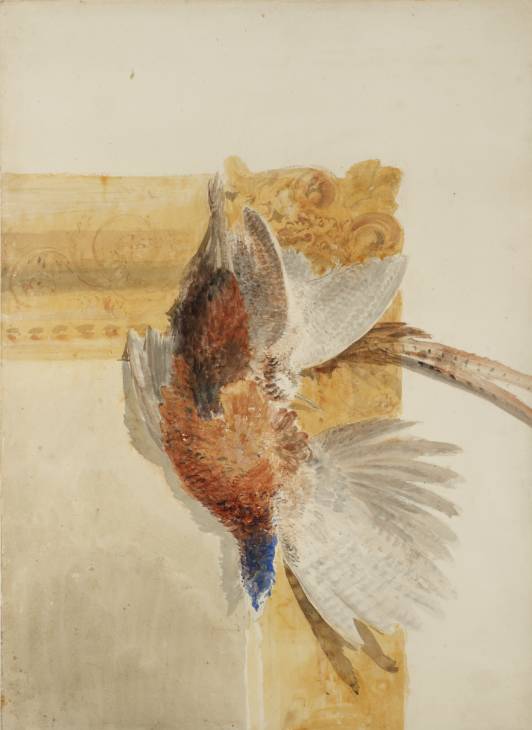J.M.W. Turner
>
1819-29 Italy and after
>
Natural History c.1820-4
>
Artwork
Joseph Mallord William Turner Study of a Dead Pheasant and Woodcock Hanging against a Picture Frame c.1820
Joseph Mallord William Turner,
Study of a Dead Pheasant and Woodcock Hanging against a Picture Frame
c.1820
Joseph Mallord William Turner 1775–1851
Study of a Dead Pheasant and Woodcock Hanging against a Picture Frame c.1820
D25481
Turner Bequest CCLXIII 358
Gouache, pencil and watercolour on white wove paper, 760 x 550 mm
Watermark ‘1818’ and ‘II S&S’ (or perhaps ‘H S&S’)
Inscribed in red ink ‘CCLXIII 358’ lower right
Stamped in black ‘CCLXIII 358’ bottom right
Turner Bequest CCLXIII 358
Gouache, pencil and watercolour on white wove paper, 760 x 550 mm
Watermark ‘1818’ and ‘II S&S’ (or perhaps ‘H S&S’)
Inscribed in red ink ‘CCLXIII 358’ lower right
Stamped in black ‘CCLXIII 358’ bottom right
Accepted by the nation as part of the Turner Bequest 1856
Exhibition history
1984
Turner’s Tour of Richmondshire/Yorkshire: In Turner’s Footsteps through the Hills and Dales of Northern England, Tate Gallery, London, July–December 1984 (no catalogue).
1988
Turner and Natural History: The Farnley Project, Tate Gallery, London, October 1988–January 1989 (42, reproduced in colour).
References
1909
A.J. Finberg, A Complete Inventory of the Drawings of the Turner Bequest, London 1909, vol.II, p.842, CCLXIII 358, as ‘Study of a pheasant hanging against a picture frame’.
1979
Andrew Wilton, J.M.W. Turner: His Life and Work, Fribourg 1979, p.373.
1984
Craig Hartley, Turner Watercolours in the Whitworth Art Gallery, exhibition catalogue, Whitworth Art Gallery, Manchester 1984, p. 45 under no.33.
1988
Anne Lyles, Turner and Natural History: The Farnley Project, exhibition catalogue, Tate Gallery, London 1988 pp.37, 38, 41, 51 under no. 14, p. 60 under no 39, p.61 under nos. 41, 43, p.[outer back cover] no.42, reproduced in colour.
1988
David Hill and Michael Densley, Turner’s Birds: Bird Studies from Farnley Hall, exhibition catalogue, Leeds City Art Gallery 1988, pp.14, 26 note 23.
1997
Charles Nugent and Melva Croal, Turner Watercolours from Manchester, exhibition catalogue, Memphis Brooks Museum of Art, Memphis 1997, p.66 under no.30.
1997
Eric Shanes, Turner’s Watercolour Explorations 1810–1842, exhibition catalogue, Tate Gallery, London 1997, pp.31, 97.
Turner’s studies of pheasants include two heads made for the Ornithological Collection compiled at Farnley Hall, the Yorkshire home of his friend and patron, Walter Fawkes(for information about this project see the introduction to this grouping). Additionally, there are a number of smaller studies of dead pheasants not apparently directly related to this endeavour.1 The two unfinished sheets in the Turner Bequest depicting a dead pheasant and woodcock, of which this is one, are considerably larger (for the other see Tate D25482; Turner Bequest CCLXIII 359). Both studies appear to be purposeful still-life compositions as opposed to pieces functioning purely as natural history studies: here, the birds are strikingly arranged against a gilt picture frame or mirror. Anne Lyles suggested that these studies could relate to a still-life commission from Walter Fawkes that was never completed, noting Fawkes’s ownership of Dutch and Flemish still life and animal paintings as possible evidence for this.2 The large size of the two sheets and the carefully arranged nature of this composition in particular points towards a function beyond the colour studies themselves.
On this sheet Turner has crafted a masterly essay in handling contrasting textures; the plumage of the birds is captured in energetic and plentiful brushstrokes, while the relative flatness of the gilt frame and accompanying picture or mirror is demonstrated using much larger areas of smooth wash. The pheasant stands out from its setting due to its more detailed treatment but also thanks to a shadow shown to the lower left of it, denoted in greyish gouache. The bright blue of the pheasant’s head is in contrast to both the yellow of the frame and the warm browns of the bodies of both the birds.
Verso:
Blank save for inscriptions: stamped in black ‘CCLXIII 358’ lower centre; stamped in black with Turner Bequest monogram lower centre.
Elizabeth Jacklin
September 2016
How to cite
Elizabeth Jacklin, ‘Study of a Dead Pheasant and Woodcock Hanging against a Picture Frame c.1820 by Joseph Mallord William Turner’, catalogue entry, September 2016, in David Blayney Brown (ed.), J.M.W. Turner: Sketchbooks, Drawings and Watercolours, Tate Research Publication, July 2017, https://www

